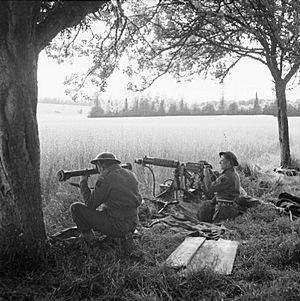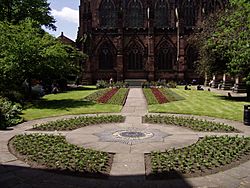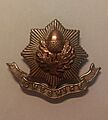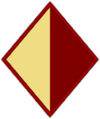Cheshire Regiment facts for kids
Quick facts for kids 22nd Regiment of Foot22nd (Cheshire) Regiment of Foot Cheshire Regiment |
|
|---|---|
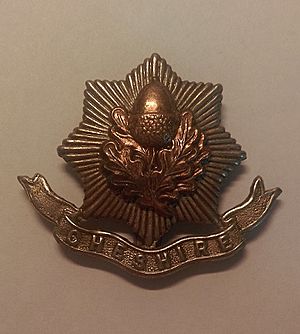
Cap badge of the Cheshire Regiment
|
|
| Active | 1689–2007 |
| Allegiance |
|
| Branch | |
| Type | Infantry |
| Role | Line infantry |
| Size | One battalion |
| Part of | Prince of Wales' Division |
| Garrison/HQ | Chester Castle (1873–1939) Dale Barracks, Upton-by-Chester (1939–2007) |
| Nickname(s) | The Old Two-twos The Young Buffs The Peep of Day Boys The Lightning Conductors The Red Knights The Specimens Twos |
| Colors | Cerise and Buff |
| March | Quick – Wha Wadna Fecht for Charlie Slow – The 22nd Regiment 1772 |
| Engagements | See honours list |
| Commanders | |
| Last Colonel-in-Chief | The Prince of Wales, KG, GCB, KT, ADC(P) |
| Colonel of the Regiment |
Brigadier A.R.D. Sharpe OBE |
| Insignia | |
| Tactical Recognition Flash |  |
The Cheshire Regiment was a famous regiment (a large group of soldiers) in the British Army. It was part of the Prince of Wales' Division. This regiment, originally called the 22nd Regiment of Foot, was started in 1689 by the Duke of Norfolk. It existed for over 300 years! In 1881, it grew bigger and officially became the 22nd (Cheshire) Regiment of Foot.
On 1 September 2007, the Cheshire Regiment joined with two other regiments to create a new, larger one called the Mercian Regiment. The Cheshire Regiment then became the 1st Battalion, Mercian Regiment.
Contents
History of the Cheshire Regiment
Early Adventures
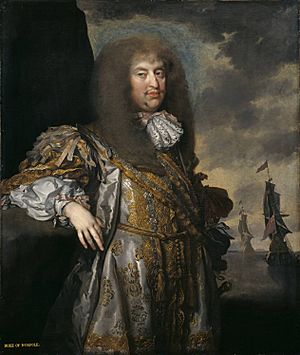
After a big change in England called the Glorious Revolution in 1688, the Duke of Norfolk formed this regiment in Chester. Back then, army groups were often named after their leader and could be disbanded easily.
In 1689, the unit was called Belasyse's Regiment of Foot. It went to Ireland to fight in the Williamite War in Ireland. They fought in important battles like The Boyne and Aughrim. After the war in Ireland, they moved to Flanders (part of modern-day Belgium) and fought in the Nine Years War, including the Battle of Landen in 1693.
To save money, many regiments were cut down, but Belasyse's Regiment was kept by being moved to the Irish army list.
In 1701, the regiment was sent to Jamaica in the West Indies. This was a very unhealthy place, and many soldiers got sick. They stayed there for twelve years. Later, in 1726, they moved to Menorca (a Spanish island) for 22 years.
By 1751, the regiment was officially known as the 22nd Regiment of Foot. In 1758, they helped capture Louisbourg in French Canada. They also fought in the famous Battle of the Plains of Abraham in 1759, which helped the British take control of Canada. They also helped capture Martinique and Cuba in 1762.
Fighting in America
The regiment went to North America in 1775 to fight in the American Revolutionary War. Their leader, Lieutenant Colonel James Abercrombie, was killed early in the war at the Battle of Bunker Hill. The regiment later fought in the New York and New Jersey campaign and the Battle of Rhode Island. Most of the regiment stayed in New York City until the war ended.
In 1782, the regiment was officially renamed the 22nd (Cheshire) Regiment of Foot, showing its connection to Cheshire county.
Wars with France
In 1793, the regiment went back to the West Indies to fight in the French Revolutionary Wars. They took part in battles on islands like Martinique and Guadeloupe. In 1800, they moved to South Africa and then to India. In India, they suffered many losses during a tough attack on Bhurtpore in 1805. In 1810, they helped take over Mauritius.
The Victorian Era
The regiment continued to serve in India, fighting in the Battle of Meeanee and the Battle of Hyderabad in 1843. These battles led to the British taking control of Sindh.
In the 1870s and 1880s, the British Army made big changes. The Cheshire Regiment was already a strong unit with two battalions (large groups of soldiers), so it didn't need to join with another regiment. On 1 July 1881, it officially became The Cheshire Regiment. Its main job was to recruit soldiers from the county of Cheshire.
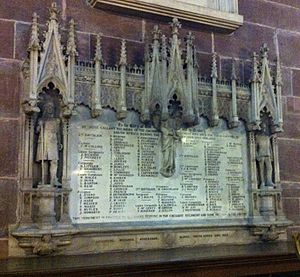
Both parts of the regiment served in Burma from 1887 to 1891. The 2nd Battalion also fought in South Africa during the Second Boer War from 1900 to 1902. Many soldiers from the regiment returned home after this war.
In 1908, the army changed again, and the regiment gained more battalions, including Reserve and Territorial units.
The First World War
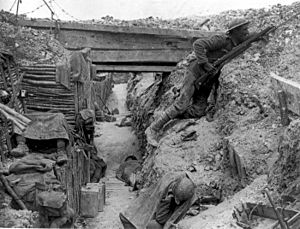
During the First World War, many battalions of the Cheshire Regiment fought bravely.
- The 1st Battalion landed in France in August 1914. They fought in many major battles on the Western Front, including the Battle of Mons, the First Battle of the Marne, and the First Battle of Ypres. They also saw action at the Second Battle of Ypres and the Battle of Passchendaele.
- The 2nd Battalion came from India and joined the fighting on the Western Front in 1915. Later, they moved to Egypt and then to Salonika.
Many other battalions, including Territorial Force units (part-time soldiers) and New Armies (newly formed units), also served. They fought in places like Gallipoli, Mesopotamia, and Salonika, as well as extensively on the Western Front in France and Belgium.
The Second World War
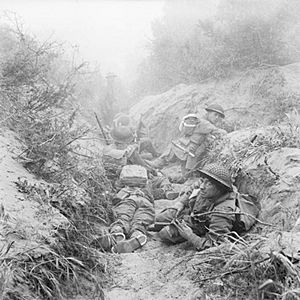
In the Second World War, the Cheshire Regiment continued its service:
- The 2nd Battalion fought in France in 1940 as part of the British Expeditionary Force. They were involved in the Battle of Dunkirk and were evacuated back to Britain.
- The 1st Battalion fought in North Africa at Tobruk and later took part in the crossing of the Rhine River in Germany in 1945.
- The 2nd Battalion also took part in the D-Day landings in 1944, a huge invasion of France.
- The 6th and 7th Battalions fought in the Italian Campaign. The 6th Battalion served in North Africa before moving to Italy.
- The 5th Battalion stayed in the United Kingdom, providing important machine gun support for other divisions.
After the Wars
After the Second World War, the 1st and 2nd Battalions joined together. The regiment was sent to many different places around the world, including Cyprus and Egypt in 1951, and Malaya in 1957.
They also served in Northern Ireland at the start of the Troubles in 1970. In 1982, a sad event occurred when eight soldiers from the Cheshires were killed in the Droppin Well bombing. The regiment also spent two years in Hong Kong from 1984 to 1986.
In 1991, the regiment was posted to Germany. They were the first armoured infantry unit to go to Bosnia in 1992 for United Nations peacekeeping duties. Later, they were deployed to Iraq in 2004 as part of Operation Telic.
Joining Forces
The Cheshire Regiment was special because it had never joined with another regiment in its long history, unlike many other units. However, in 2004, the army decided to reorganize. It was announced that the Cheshire Regiment would join with the Staffordshire Regiment and the Worcestershire and Sherwood Foresters Regiment to form the new Mercian Regiment. In August 2007, the Cheshire Regiment officially became the 1st Battalion, the Mercian Regiment.
Regimental Museum
You can learn more about the Cheshire Regiment at the Cheshire Military Museum, which is located at Chester Castle.
Alliances Around the World
The Cheshire Regiment had special connections, called alliances, with other military units:
 Canada – The Cape Breton Highlanders (Canada)
Canada – The Cape Breton Highlanders (Canada) Canada – 2nd Battalion, The Nova Scotia Highlanders (Cape Breton) (Canada)
Canada – 2nd Battalion, The Nova Scotia Highlanders (Cape Breton) (Canada) New Zealand – 22nd Battalion (The Richmond Regiment) (New Zealand)
New Zealand – 22nd Battalion (The Richmond Regiment) (New Zealand) India – 5th Battalion (Napiers), The Rajputana Rifles (India)
India – 5th Battalion (Napiers), The Rajputana Rifles (India)
Battle Honours
Battle honours are special awards given to regiments for their bravery and success in battles. The Cheshire Regiment earned many battle honours throughout its history, including for major conflicts like:
- Louisburg, Martinique 1762, Havannah, Meeanee, Hyderabad, Scinde, South Africa 1900–02
- The Great War: Mons, Ypres 1914 '15 '17 '18, Somme 1916 '18, Arras 1917 '18, Messines 1917 '18, Bapaume 1918, Gallipoli 1915, Egypt 1915–17, Gaza, Kut al Amara 1917
- The Second World War: Dunkirk 1940, Normandy Landing, Capture of Tobruk, El Alamein, Mareth, Sicily 1943, Salerno, Rome, Gothic Line, Malta 1941–42
Victoria Crosses
The Victoria Cross is the highest award for bravery in the British military. Two men from the Cheshire Regiment received this honour:
- Second Lieutenant Hugh Colvin, during the First World War (20 September 1917)
- Private Thomas Alfred Jones, during the First World War (25 September 1916)
Images for kids




